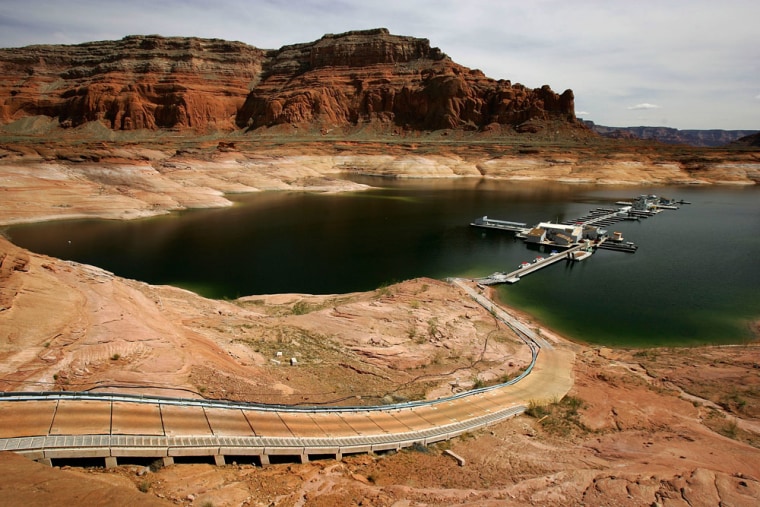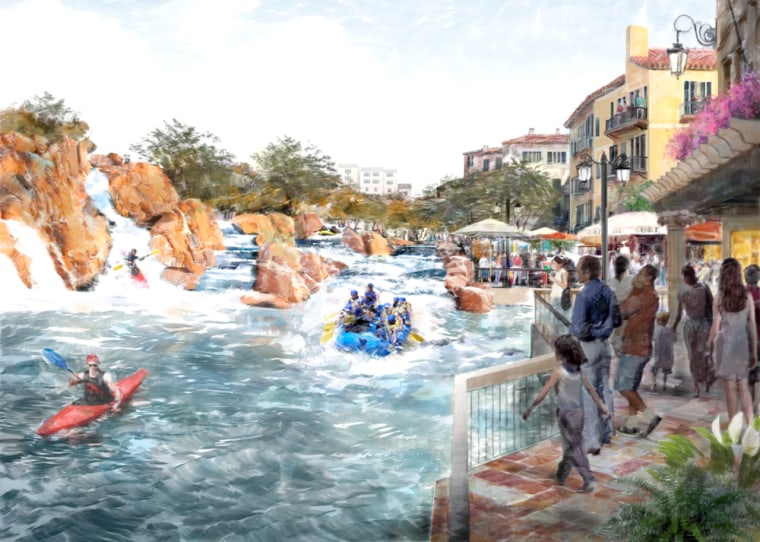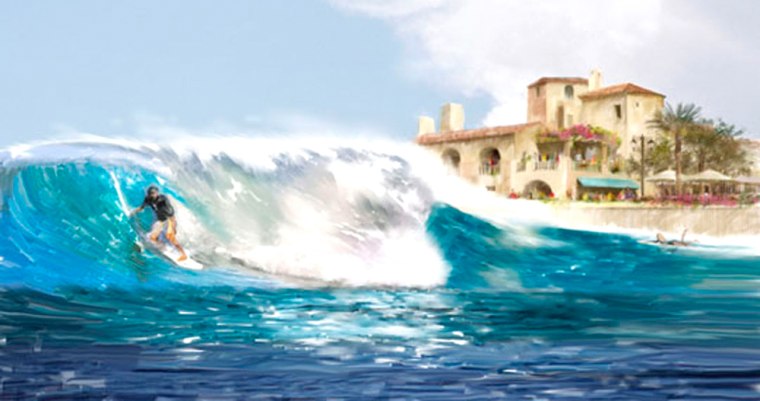By tapping rivers and sucking water from deep underground, developers have covered Arizona with carpets of Bermuda grass and dotted the parched landscape with swimming pools, golf courses and lakeshore homes.
Now another ambitious project is in the works: A massive new water park that would offer surf-sized waves, snorkeling, scuba diving and kayaking — all in a bone-dry region that gets just 8 inches of rain a year.
"It's about delivering a sport that's not typically available in an urban environment," said Richard Mladick, a Mesa real-estate developer who persuaded business leaders in suburban Mesa to support the proposal called the Waveyard.
Artists' drawings of the park show surfers gliding through waves that crash onto a sandy beach and kayakers navigating the whitecaps of a wide, roiling river. Families watch the action from beneath picnic umbrellas. If constructed, the park would use as much as 100 million gallons of groundwater a year.
Mladick, 39, said he wanted to create the kind of lush environment he remembers from growing up in Virginia Beach, Va., and surfing in Morocco, Indonesia, Hawaii and Brazil.
"I couldn't imagine raising my kids in an environment where they wouldn't have the opportunity to grow up being passionate about the same sports that I grew up being passionate about," he said.
The Waveyard, to be built 15 miles east of Phoenix, would dwarf the typical water-slide parks familiar to many Arizona families.
It will include an artificial whitewater river with multiple channels where kayakers can test themselves on Class 2 to Class 4 rapids. Visitors could enjoy an artificial beach and a simulated ocean capable of producing different size waves, from 12-foot barreling waves to tamer chop for boogie boarders.
The 125-acre park will feature a scuba lagoon, a snorkeling pond with reefs and a rock-climbing center.
The Waveyard is envisioned as the summer equivalent of a ski resort — only with more choices, Mladick said. "We really struggle with the theme-park comparison. This is based on skilled sports."
The park will also have restaurants, a shopping district, a spa, and a hotel and conference center.
Jerry Hug, a businessman who co-founded the project, said he expects it will eventually generate more than $1 billion in revenue and create 7,500 jobs. That is especially attractive in Mesa, a city of about 460,000 people that has struggled to keep up with the booming development of its neighbors.
"We don't have a property tax in our city," said Eric Jackson, chairman of the Mesa Chamber of Commerce. "It requires us to be very heavily dependent on revenues from sales taxes."
Voters approved tax break
Mesa voters overwhelmingly approved their proposal on Nov. 6, granting the Waveyard an estimated $35 million in tax incentives with more than 65 percent of the vote.

No citizens groups overtly opposed the project, but its water usage may raise questions in the future as the growing Phoenix areas struggles to replenish its vast aquifer. Arizona has been in a drought for a decade, and rivers that feed Phoenix and surrounding communities experienced near-record low measurements this year.
"Water is a scarce and valued commodity," said Jim Holway, associate director of the Global Institute of Sustainability at Arizona State University.
Holway said the Phoenix area currently enjoys huge supplies of underground water. But it's tough to determine exactly how long communities can sustain their rate of water consumption, given that global warming may make the desert even drier.
The Waveyard will need as much as 50 million gallons of water at first to fill its artificial oceans and rivers.
Replenishing water lost to evaporation and spillage will require another 60 to 100 million gallons per year, enough to support about 1,200 people in the Phoenix area.
Vow not to use drinking water
Project organizers say they won't tap Mesa's drinking water supplies to fill the park. Instead, they plan to draw from a well that has elevated levels of arsenic, which makes its water unsuitable for drinking. The Waveyard will build a treatment plant to make the water safe for swimmers.

Rita Maguire, a former director of the Arizona Department of Water Resources who studied water availability for Waveyard developers, said the project will not use any more water than one of Arizona's many golf courses.
"Initially, the reaction is, 'Oh my. Is this an appropriate use of water in a desert?'"
"But recreation is a very important part of a community. And if you can make the use of that water in a highly efficient way, it's a smart choice," she said.
Holway agreed, saying communities could do a better job using water in public spaces "that everybody can enjoy as opposed to having lush yards that we just lock behind fences."
"From that point of view, maybe this is a good thing."
